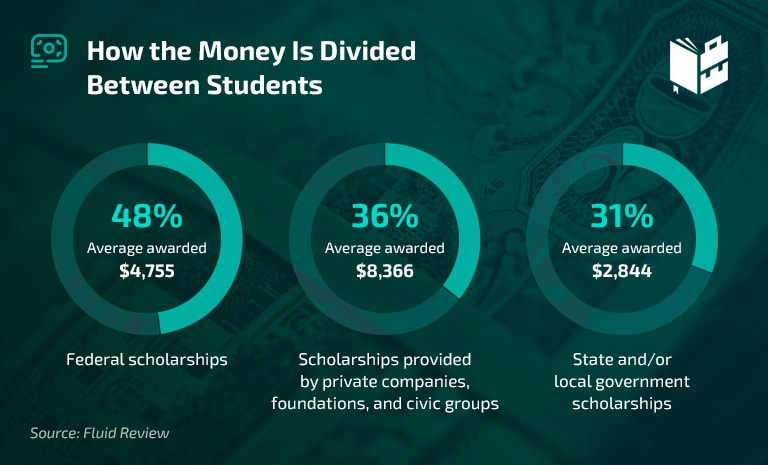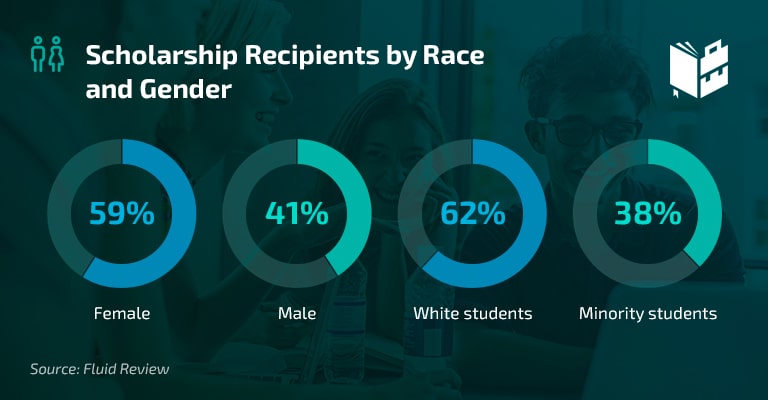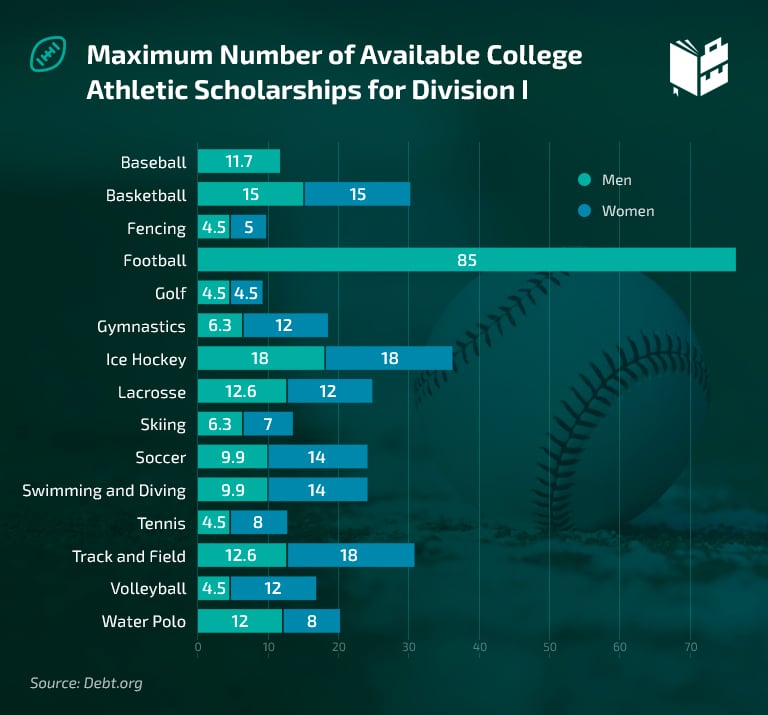A scholarship can be defined as an amount of money given to a student to help them pay for their studies. Most scholarships are merit based or, in other words, awarded to students due to their extraordinary academic or athletic achievements.
The latest scholarship stats include vital information for future college applicants, as this type of financial aid, along with grants, doesn’t need to be repaid. Student loans, on the other hand, need to be paid off with interest.
We have compiled a list consisting of the most important questions regarding these statistics.
Fascinating Scholarship Facts and Stats (Editor’s Pick)
- The average scholarship is worth $7,400.
- Only 0.2% of students got $25,000 or more in scholarships per year.
- The NCAA awards more than $2.9 billion in athletics scholarships annually.
- 48% of students receive federal scholarships.
- Only 1.3% of athletes receive a full or partial athletic scholarship.
- An average scholarship for athletes is around $5,000.
- College baseball players receive around 5,400 scholarships.
- Division I soccer teams receive an average of 12 scholarships.
General Scholarship Statistics
How many types of scholarships are there?
Scholarships can be grouped into three different categories:
- Merit-based scholarships that can be:
- Academic — for candidates with an exceptional academic performance
- Athletic — for candidates with athletic skills
- Artistic — for candidates talented in arts
- Need-based scholarships — for candidates from low-income families
- Scholarships for minorities and other groups — based on personal, social, or demographic criteria, such as race, religion, sexual orientation, family associations, place of origin, medical history, and similar.
What are the most common scholarships?
The most common types of scholarships are merit based, mostly on academic or athletic achievement.
To qualify for an academic scholarship, an applicant must have a high GPA, a high score on standardized tests like the SAT and GRE, and other measurable academic achievements.
Exceptional athletes applying for athletic scholarships also need to have a good academic background. Another factor that can influence a candidate’s chance of receiving a scholarship is an age restriction.
What percentage of people get scholarships?
It seems that, for most students, financial aid is much welcomed. According to the 2019–20 National Postsecondary Student Aid Study (NPSAS:20), 44.6% of undergraduates received financial aid from their institution in spring 2020.
In comparison, the 2015–16 National Postsecondary Student Aid Study (NPSAS:16) showed that 63.3% of undergraduate students received a certain type of grant. This includes grants, scholarships, or tuition waivers from federal, state, institutional, or private sources, including employers. The percentage of graduate students who received a grant is 40.3%. The NPSAS:16 sample consisted of about 89,000 undergraduate and 24,000 graduate students.
How much is the average scholarship worth?
According to the same study, the average grant received by an undergraduate student is $7,400. In addition, the average amount received by a graduate student is higher — $9,500. A different source claims that the average amount awarded depends on where the money came from. However, according to the book Secrets to Winning a Scholarship by Mark Kantrowitz, the average scholarship amount per student is $2,800 a year.
Where did this money come from?
According to an infographic on scholarships made by Fluid Review, $49 billion were awarded in scholarships in the school year 2010/2011.
Federal, state, and local government sources provided $46 billion. On the other hand, private companies, foundations, and civic groups provided $3 billion.
To put into perspective how the money was divided between students:
- 48% of students received money from federal scholarships
- 36% of students received money from scholarships provided by private companies, foundations, and civic groups
- 31% of students received money from state and/or local government scholarships.
Regarding funding, there are some surprising scholarship stats. Namely, the fast food and soft drink industry provided $.5.5 million in scholarship funds.

Each year, these companies give students in the US the following amount of money:
- $3 million is given by Coca Cola
- $1 million is given by KFC
- $1 million is given by Dr. Pepper
- $500 thousand is given by McDonald’s.
Combined, these companies make $15 billion in profits. Therefore, the amount they give away represents a tiny 0.3% of their profits.
What percentage of students get a full ride scholarship?
If you are a future college applicant hoping to get a full ride scholarship, we regret to inform you that the odds aren’t in your favor. It seems that only 0.2% of students get $25,000 or more in scholarships per year.
The aforementioned Mark Kantrowitz analyzed the data from the 2015–16 National Postsecondary Student Aid Study (NPSAS) and found the following scholarship stats:
- 1.5% of students in bachelor’s degree programs got enough grants and scholarships to cover 100% of the cost of attendance;
- 2.7% received enough to cover 90% of attendance costs;
- 5.9% were granted enough to cover 75% of the cost of attendance;
- 18.8% received enough to cover 50% of the cost of attendance.
Is there financial aid for minorities and other groups?
Scholarship statistics show that, each year, a significant amount of money is awarded to students based on their race, gender, ethnicity, sexual orientation, and similar.
Numerous scholarships are targeted at women, Native Americans, veterans, students from the LGBT community, and students belonging to a minority.
It seems that scholarships are equally distributed between sexes — 59% of recipients are female and 41% are male.

According to scholarship statistics by race, only 38% of recipients are minority students, and 62% are white students.
Moreover, students who are at least one-quarter Hispanic/Latino can receive awards between $500 and $5,000 from the Hispanic Scholarship Fund. To qualify, they need a GPA of 3.00 or higher.
On the other hand, the Asian and Pacific Islander American Scholarship Fund (APIASF) has 13 scholarship programs. In fact, their sponsors have awarded $80 million in grants since 2003.
The Blacks At Microsoft (BAM) scholarship gives $5,000 to students of African descent interested in technology.
College Athletic Scholarships Facts
How are athletic scholarships divided?
The National Collegiate Athletic Association (NCAA) groups colleges and universities into three groups and supplies some of the funds that schools offer to their students.
- Division I — colleges and universities with the most competitive athletic programs.
- Division II — smaller colleges and universities with less competitive programs.
- Division III — colleges and universities that are more academically focused yet offer academic opportunities.
How much is the average athletic scholarship worth?
Annually, the NCAA awards more than $2.9 billion in athletic scholarships to over 150,000 student-athletes.
Students can receive financial aid in the following forms:
- A full ride scholarship
- A partial scholarship
- A tuition and fees scholarship
- A room and board scholarship
The actual awarded amount depends on the school’s cost of attendance; however, the percentage of covered expenses will be the same.
The average athletic scholarship amount is around $17,142 per student. However, not every student receives this much. Most athletes get around $5,000.
What percentage of students receive athletic scholarships?
Skilled athletes should consider having a backup plan when it comes to paying for college. Only around 1.3% of high school athletes are awarded some sort of athletic scholarship. Compared to what percentage of students get scholarships in general, the number is very low.
How many students receive a full ride athletic scholarship?
If only around 1.3% of high school athletes receive a certain type of scholarship, we can assume that the number of athletes receiving a full ride is lower than 1%. If we look at academic scholarships vs. athletic scholarships statistics, we will see that college applicants have a higher chance of receiving aid based on academic merit.
How to increase your chances of receiving an athletic scholarship?
Having outstanding athletic performance is not the only deciding factor. While it can be considered the most important one, there are other ways to increase your chances of getting a college sports scholarship.
For instance, choosing the right sport can boost your chances of receiving financial aid. Some of the easiest sports scholarships to get are those aimed at track and field athletes. However, playing a second sport also significantly increases your chances.
That being said, there are some age restrictions as well. Applicants should be between 16 and 25 if they want to apply for a sports scholarship.
Of course, maintaining a high GPA should be a top priority for high school students, as academic achievement is also taken into consideration. In addition, committees need to select applicants with good grades, as there is a limit on the scholarships they can award.
According to scholarship stats regarding the number of scholarships schools can award, the maximum number is usually no more than 30 students per sport.
What are your chances of getting a soccer scholarship?
In the school year 2019–20, there were 476,203 male high school soccer players and 408,807 female high school soccer players. In the same school year, the number of male college soccer players was 42,112, and the number of female college soccer players stood at 41,975.
According to scholarship stats, soccer teams in Division I get around a dozen scholarships per year. The women’s team gets 14, and the men’s team gets 10 scholarships.
However, these are the maximum scholarships allowed, so the number may be smaller if the school has budget limits. In fact, the percentage of male high school soccer players who compete at the NCAA Division 1 level is lower than 1%.
What are the baseball scholarship stats?
Only around 5,400 scholarships are granted to college baseball players.
Division I schools have a limit of 11.7 scholarships per year. These scholarships can be divided among a maximum number of 27 players, and players need to receive a minimum of 25% of the scholarship. On the other hand, Division II schools offer an even lower number of scholarships, with an upper limit of nine scholarships per year.
Getting a full ride baseball scholarship is very rare. Coaches usually divide the amount among their players, giving them a partial scholarship.
What are the golf scholarship stats?
Much like baseball, golf is an equivalency sport. This means that coaches split the amount of money intended for scholarships among players. Likewise, a full ride scholarship for a golf player is rare.
In the school year 2019–20, there were 168,480 male high school golf players and 96,071 female high school golf players. At the college level, there were 11,867 male golfers and 7,276 female golfers.
If we look at statistics, scholarships for golf players weren’t plentiful. Division I schools’ maximum limit was 4.5 scholarships for male players per team and 6 scholarships for female players per team. There were 301 male teams with an average team size of 10 golf players and 270 female teams with an average team size of eight golf players.

What are the volleyball scholarship statistics?
In the school year 2019–20, there were 477,117 female high school volleyball players and 67,243 male high school volleyball players. At a college level, the number of female volleyball players was 28,796. On the other hand, the number of male college volleyball players was 3,929.
Now, Division I schools have a maximum limit of 12 scholarships for female players per team. On the other hand, the maximum limit of scholarships for male players per team is 4.5.
Volleyball is considered a headcount sport, so all the student-athletes will get a full ride scholarship.
How many track scholarships are given each year?
In the school year 2019–20, there were 617,583 male track and field athletes and 498,131 female track and field athletes. At the college level, there were 36,566 male track and field athletes and 36,106 female track and field athletes.
There were 291 male track and field teams and 341 female track and field teams. Moreover, the average team size was 39 players for male teams and 40 players for female teams. Division I schools had a maximum limit of 12.6 scholarships for men and 18 for women.
Does track offer full ride scholarships?
Most track and field scholarships are partial. Coaches usually divide the available amount of money among players to increase the number of top athletes in their team.
Full ride track and field scholarships are considered very rare. The deciding factor for offering a scholarship is how big of an impact a potential scholarship candidate can have on the team.
Are Scholarship Statistics in Your Favor?
Most scholarships don’t cover the full costs of going to college. Less than 2% actually cover all the expenses incurred by going to college, while the rest of them cover a certain percentage of the costs.
What’s more, the competition for academic and athletic scholarships is fierce, and the requirements are strict. As a result, the percentage of students getting scholarships is small, while the percentage of those receiving enough financial aid is even smaller. Considering how many students get scholarships, scholarship stats show that 45% of students graduated with a high average student loan debt.